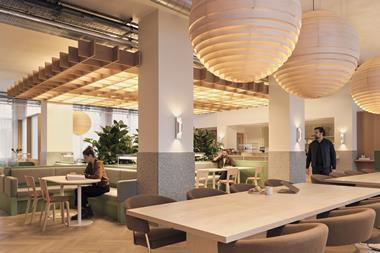With the recent reopening of the retail and hospitality industry, a new sense of hope has emerged. As the government reopens society step by step, the return to the office is on the horizon.

However, many people have seen an improvement during their work/life balance during the pandemic and there are mixed feelings about returning to ‘business as usual’.
Before the pandemic, remote working would not have been accepted by the vast majority of employers, being deemed detrimental to productivity. Now, with the possibility of high-speed internet and video conferencing, many people enjoy working from home. Those people now expect forward-thinking workplaces that allow for flexibility.
Data from a VoxEU survey of 4,809 UK residents found 49% felt optimistic about working from home two or three days a week post Covid, while 49% said that productivity at home was about the same as in the office.
Similarly, in our At Home survey in 2020, Perkins&Will’s employees voted in favour of a more flexible-orientated future, as expectations for home working grew by 38% throughout the lockdown.
We have been surveying our clients and finding similar results. They have an increased expectation for more flexibility and an acceptance of more work/life balance.
As much as offices will potentially be used differently, they are still crucial to productivity and culture. People don’t miss the commute to and from work, but they miss the community aspects that come with working as part of a team.
Rethinking the space
As employers embrace the new flexible working arrangements, architects and designers have an opportunity to reshape how office space functions. Offices need to adapt and optimise to meet diverse working methods and styles while also meeting the health and safety concerns of a post-pandemic world.
Offices should aim to transcend their primary functions as workspaces and strive to be places of innovation and creativity.
People don’t miss the commute but they miss the community aspects
This will naturally result in a different aesthetic for every industry and business. Office spaces will gradually lose their homogeneity in favour of workspaces tailored to meet the users’ needs. Employers will have to embrace this user-centred design approach to achieve maximum productivity in a flexible working environment.
Company culture may be compromised in an office filled with a mix of physical and virtual workers. Employers will have to innovate to keep it alive. Coming into the office should be an experience desired by employees. Collaboration between sectors will also be essential, as employers must take advantage of communal workspaces. This should be an ongoing conversation between employers and employees, benefiting both parties.
Additionally, with the shift towards sustainability, employees will also be looking for economic, environmental and social sustainability in their workplace. This does not necessarily mean tearing down office blocks and building new co-working-style spaces, but redesigning existing spaces to support new working methods that have emerged.
The need for offices is not dead, but in a post-pandemic world, we must rethink how we approach the workplace to keep it alive.
Kate Vine is a principal at Perkins&Will London






























No comments yet